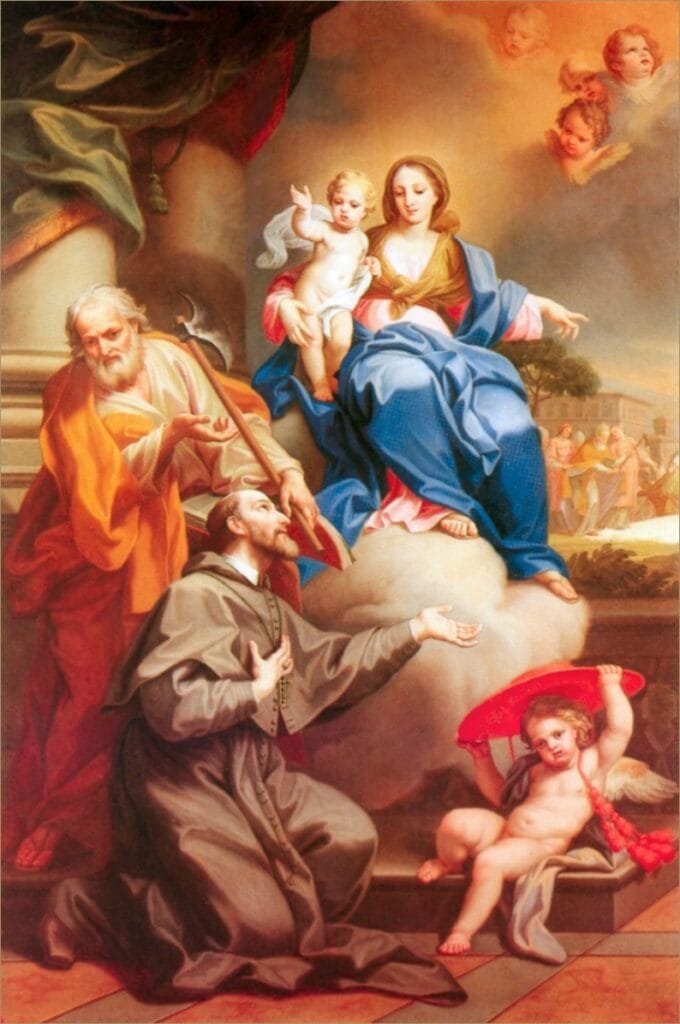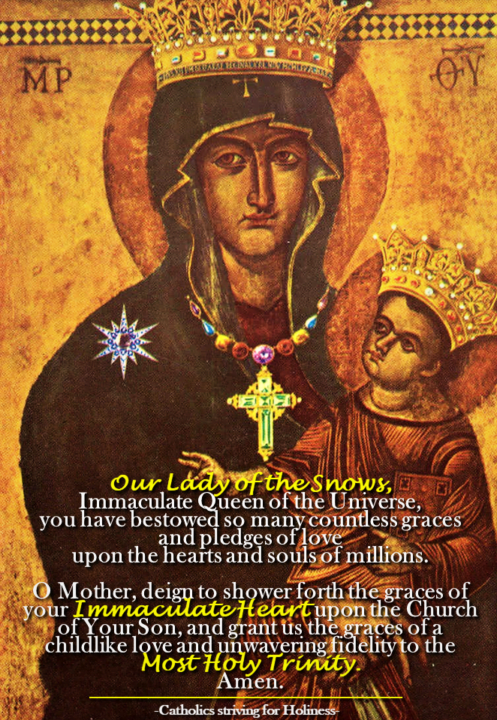AUGUST 5:
OUR LADY OF THE SNOWS.
Dedication of the Basilica of St. Mary Major (Rome). History. Prayer.

The Basilica of St. Mary Major, dedicated by Pope Sixtus III in honor of the Mother of God after the declaration of the dogma of the divine Maternity of the Blessed Virgin in the Council of Ephesus (year 431), is considered as the oldest church in the West dedicated to the Blessed Virgin Mary.
Its history is related to the feast of Our Lady of the Snows and the miracle which occurred on Aug 5, 352 A.D. when the devotion to Our Lady under this title began. Below you will find its interesting history taken entirely from www.catholictradition.org.
******
THE PATRICIAN JOHN IN ROME BEFORE THE MIRACLE OF THE SNOW IN 352
A WEALTHY aristocrat and devout Christian known by tradition as John lived in Rome in the fourth century. He and his wife had no children, and were fearful that their lack of an heir would put an end to the family’s long prominence in the government of the city. They had often prayed for a child but without success. One day John’s wife said, “Let us ask the Blessed Virgin to nominate an heir.” They did so, and their prayer was answered dramatically.
SNOW IN AUGUST
In August 352 a rectangle of snow was discovered on Mount Esquiline, one of the famous Seven Hills. Snowfall of any sort was unheard of in Rome at that time of year, but that it had fallen only in one place and in such a specific pattern was regarded as a phenomenon. People crowded to see the patch of snow, which persisted despite the heat. John was convinced that its shape and size indicated that a church should be built on the spot. In fact both John and the Pontiff had dreamt that Our Lady desired a church to be built on Mount Esquiline. The Holy Father was so moved by his dream that he visited the mysterious snowfall. When he arrived with his retinue, John and his wife were already there kneeling in prayer to the Virgin.
As soon as the plot for the building had been staked out the snow melted. John met the cost of the building, which was completed in 354 and was dedicated the Basilica Liberiana. Seventy years later the church was rebuilt on a grander scale by Pope Sixtus III, who added decorations and ornaments of silver. From then the church was known as Basilica Sixti and the Church of Santa Maria Maggiore [St. Mary Major].
THE PRODIGY OF THE SNOW IS TRUE
The new basilica housed a celebrated painting provided by the Pope. It had belonged to St. Helen, the mother of the Emperor Constantine—–the same Helen who, according to tradition, had made a pilgrimage to Palestine and discovered the original Cross of Christ. The picture, painted on a slab of cedar wood, is of a Madonna and Child. The infant Jesus is holding a book and both figures are haloed and crowned—–the crowns presented by Pope Gregory XVI in 1832 as a thank-offering for deliverance from cholera.

The so-called ‘new’ Lady Chapel was built by Pope Paul V in 1613 to house the miraculous painting. He declared, “This image should have a magnificent place of its own, befitting its eminence. For it has always been regarded by all faithful people and through it many miracles and wonders have been wrought.”
Salus Populi Romani [Salvation of the Roman People] is the title of this famous painting and it is rightly named because for centuries the people of Rome have prayed before it in times of famine, war and national crisis.
Many popes have held the basilica on Mount Esquiline in particular regard. When Gregory I was Pope [590-604] Rome was ravaged by a plague. Gregory carried the image of the Holy Mother in procession from the chapel as far as Hadrian’s Mausoleum. When the procession arrived they heard an invisible heavenly choir singing Regina Caeli. When the Pope asked the Virgin to pray for the city he saw an apparition of St. Michael replacing the sword of vengeance in its scabbard. The plague abated.
Pope Benedict XIV had a special affection for the legend. In 1427 he declared, “It must be acknowledged that nothing is wanting to enable us to affirm with moral certainty that the prodigy of the Snow is true: Benedict XVI attended the holy picture every Saturday and prayed the Litany. The night before he died, Paul V asked to be taken to the Chapel of the Blessed Virgin in order to pray before her image. St. Ignatius Loyola, founder of the Society of Jesus, said his first Mass here at Christmas 1538.
THE BASILICA TODAY
The present-day church is one of the largest basilicas in the world and its Patronal Festival is held on August 5 in remembrance of the miracle of the snow. During this celebration hundreds of white blossoms are showered from the dome of the chapel. Not to be missed are the thirteenth-century mosaics on biblical themes and the frescoes by Reni and Della Porta. There is an imposing Romanesque bell tower erected in 1377.
Santa Maria Maggiore has a further claim to fame. In the seventh century a relic was brought from Bethlehem and traditionally venerated as the manger in which the Christ Child was laid at the first Christmas. And so another name for the great basilica is St. Mary of the Crib.
One of the most spectacular sights which meets today’s pilgrim is the triumphal arch which extends to almost 66 feet. It is decorated in four horizontal sections. In the middle at the top God’s throne is set in a circle, with St. Peter and St. Paul on either side. Above this mosaic are the symbols of the four Gospel writers.
On November 12, 1964 Pope Paul VI made a pilgrimage to the basilica and solemnly proclaimed Our Lady “Mother of the Church.”
*****
PRAYER TO OUR LADY OF THE SNOWS
Our Lady of the Snows, Immaculate Queen of the Universe,
you have bestowed so many countless graces and pledges of love
upon the hearts and souls of millions.
O Mother, deign to shower forth the graces of your Immaculate
Heart upon the Church of Your Son, and grant us the graces of a
childlike love and unwavering fidelity to the Most Holy Trinity. Amen.
TEXT SOURCE: http://www.catholictradition.org/Mary/snows.htm
PHOTO SOURCE: Gaetano Lapis, “The Madonna of the Snows” (1720) in http://www.catholictradition.org/Mary/snows2.htm with the following description:
“This image is in the Church of St. Francis, Rome; In the center right the artist has depicted the Miracle of the Snow with the Pontiff: the figure in front. Our Lady is pointing to the Miracle.
The figures before the Madonna and Child are the Apostle, St. Matthias [who replaced Judas], for certain because he carries the battle-ax which is his symbol; and St. Charles Borromeo—–I think—–because of the likeness of the profile to actual known images of the Saint. Our manifest does not provide these figures’ identity. St. Charles was a central, towering figure of the Counter-Reformation period, and the artist primarily executed his pieces as a Counter-Reformation work.
This painting is one of the most beautiful Madonnas and we give thanks to God that He is so generous in providing us with a copy. For this benefice from Him we are indebted to the Sisters of the St. Benedict Center in Still River, Massachusetts, who passed it along to me many years ago.”
Stay updated: subscribe by email for free TO OUR NEW WEBSITE www.catholicsstrivingforholiness.org (PUT YOUR EMAIL IN THE SUBSCRIBE WIDGET).
We are also in www.fb.com/Catholicsstrivingforholiness. Kindly help more people in their Christian life by liking our page and inviting your family, friends and relatives to do so as well. Thanks in advance and God bless you and your loved ones! Fr. Rolly Arjonillo